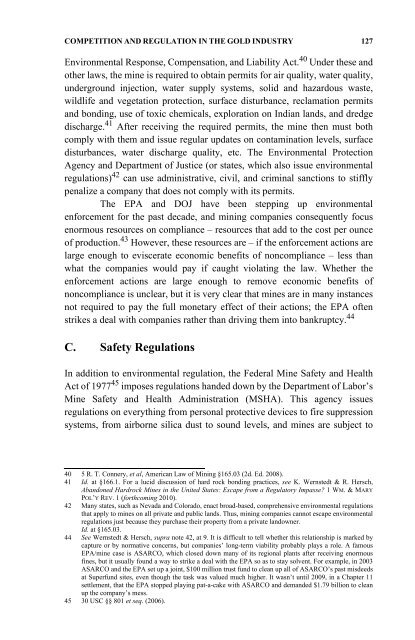University of Botswana Law Journal - PULP
University of Botswana Law Journal - PULP
University of Botswana Law Journal - PULP
Create successful ePaper yourself
Turn your PDF publications into a flip-book with our unique Google optimized e-Paper software.
COMPETITION AND REGULATION IN THE GOLD INDUSTRY 127<br />
Environmental Response, Compensation, and Liability Act. 40 Under these and<br />
other laws, the mine is required to obtain permits for air quality, water quality,<br />
underground injection, water supply systems, solid and hazardous waste,<br />
wildlife and vegetation protection, surface disturbance, reclamation permits<br />
and bonding, use <strong>of</strong> toxic chemicals, exploration on Indian lands, and dredge<br />
discharge. 41 After receiving the required permits, the mine then must both<br />
comply with them and issue regular updates on contamination levels, surface<br />
disturbances, water discharge quality, etc. The Environmental Protection<br />
Agency and Department <strong>of</strong> Justice (or states, which also issue environmental<br />
regulations) 42 can use administrative, civil, and criminal sanctions to stiffly<br />
penalize a company that does not comply with its permits.<br />
The EPA and DOJ have been stepping up environmental<br />
enforcement for the past decade, and mining companies consequently focus<br />
enormous resources on compliance – resources that add to the cost per ounce<br />
<strong>of</strong> production. 43 However, these resources are – if the enforcement actions are<br />
large enough to eviscerate economic benefits <strong>of</strong> noncompliance – less than<br />
what the companies would pay if caught violating the law. Whether the<br />
enforcement actions are large enough to remove economic benefits <strong>of</strong><br />
noncompliance is unclear, but it is very clear that mines are in many instances<br />
not required to pay the full monetary effect <strong>of</strong> their actions; the EPA <strong>of</strong>ten<br />
strikes a deal with companies rather than driving them into bankruptcy. 44<br />
C. Safety Regulations<br />
In addition to environmental regulation, the Federal Mine Safety and Health<br />
Act <strong>of</strong> 1977 45 imposes regulations handed down by the Department <strong>of</strong> Labor’s<br />
Mine Safety and Health Administration (MSHA). This agency issues<br />
regulations on everything from personal protective devices to fire suppression<br />
systems, from airborne silica dust to sound levels, and mines are subject to<br />
40 5 R. T. Connery, et al, American <strong>Law</strong> <strong>of</strong> Mining §165.03 (2d. Ed. 2008).<br />
41 Id. at §166.1. For a lucid discussion <strong>of</strong> hard rock bonding practices, see K. Wernstedt & R. Hersch,<br />
Abandoned Hardrock Mines in the United States: Escape from a Regulatory Impasse? 1 WM. & MARY<br />
POL’Y REV. 1 (forthcoming 2010).<br />
42 Many states, such as Nevada and Colorado, enact broad-based, comprehensive environmental regulations<br />
that apply to mines on all private and public lands. Thus, mining companies cannot escape environmental<br />
regulations just because they purchase their property from a private landowner.<br />
43 Id. at §165.03.<br />
44 See Wernstedt & Hersch, supra note 42, at 9. It is difficult to tell whether this relationship is marked by<br />
capture or by normative concerns, but companies’ long-term viability probably plays a role. A famous<br />
EPA/mine case is ASARCO, which closed down many <strong>of</strong> its regional plants after receiving enormous<br />
fines, but it usually found a way to strike a deal with the EPA so as to stay solvent. For example, in 2003<br />
ASARCO and the EPA set up a joint, $100 million trust fund to clean up all <strong>of</strong> ASARCO’s past misdeeds<br />
at Superfund sites, even though the task was valued much higher. It wasn’t until 2009, in a Chapter 11<br />
settlement, that the EPA stopped playing pat-a-cake with ASARCO and demanded $1.79 billion to clean<br />
up the company’s mess.<br />
45 30 USC §§ 801 et seq. (2006).
















